
Synapsida is one of the two major clades of vertebrate animals in the group Amniota, the other being the Sauropsida. The synapsids were the dominant land animals in the late Paleozoic and early Mesozoic, but the only group that survived into the Cenozoic are mammals. Unlike other amniotes, synapsids have a single temporal fenestra, an opening low in the skull roof behind each eye orbit, leaving a bony arch beneath each; this accounts for their name. The distinctive temporal fenestra developed about 318 million years ago during the Late Carboniferous period, when synapsids and sauropsids diverged, but was subsequently merged with the orbit in early mammals.

Therapsida is a clade composing of a major group of eupelycosaurian synapsids that includes mammals and their ancestors and close relatives. Many of the traits today seen as unique to mammals had their origin within early therapsids, including limbs that were oriented more underneath the body, resulting in a more "standing" quadripedal posture, as opposed to the lower sprawling posture of many reptiles and amphibians.
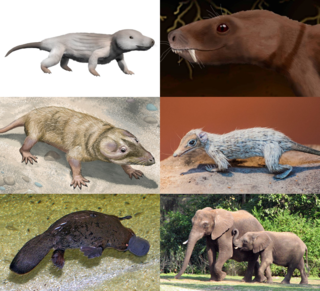
Cynodontia is a clade of eutheriodont therapsids that first appeared in the Late Permian, and extensively diversified after the Permian–Triassic extinction event. Mammals are cynodonts, as are their extinct ancestors and close relatives (Mammaliaformes), having evolved from advanced probainognathian cynodonts during the Late Triassic.

Eucynodontia is a clade of cynodont therapsids including mammals and most non-mammalian cynodonts. The oldest eucynodonts are known from the Early Triassic and possibly Late Permian. Eucynodontia includes two major subgroups, Cynognathia and Probainognathia.
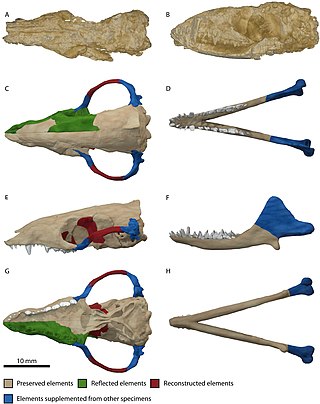
Morganucodon is an early mammaliaform genus that lived from the Late Triassic to the Middle Jurassic. It first appeared about 205 million years ago. Unlike many other early mammaliaforms, Morganucodon is well represented by abundant and well preserved material. Most of this comes from Glamorgan in Wales, but fossils have also been found in Yunnan Province in China and various parts of Europe and North America. Some closely related animals (Megazostrodon) are known from exquisite fossils from South Africa.

Allotheria is an extinct clade of mammals known from the Mesozoic and early Cenozoic. Shared characteristics of the group are the presence of lower molariform teeth equipped with longitudinal rows of cusps and enlarged incisors. Typically, the canine teeth are also lost. Allotheria includes Multituberculata, Gondwanatheria, and probably Haramiyida, although some studies have recovered haramiyidans to be basal mammaliaforms unrelated to multituberculates. Allotherians are often placed as crown group mammals, more closely related to living marsupials and placentals (Theria) than to monotremes or eutriconodonts, though some studies place the entirety of Allotheria outside of crown Mammalia.

Megazostrodon is an extinct genus of basal mammaliaforms belonging to the order Morganucodonta. It is approximately 200 million years old. Two species are known: M. rudnerae from the Early Jurassic of Lesotho and South Africa, and M. chenali from the Late Triassic of France.
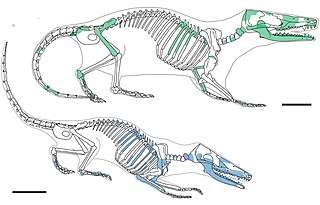
Docodonta is an order of extinct Mesozoic mammaliaforms. They were among the most common mammaliaforms of their time, persisting from the Middle Jurassic to the Early Cretaceous across the continent of Laurasia. They are distinguished from other early mammaliaforms by their relatively complex molar teeth. Docodont teeth have been described as "pseudotribosphenic": a cusp on the inner half of the upper molar grinds into a basin on the front half of the lower molar, like a mortar-and-pestle. This is a case of convergent evolution with the tribosphenic teeth of therian mammals. There is much uncertainty for how docodont teeth developed from their simpler ancestors. Their closest relatives may have been certain Triassic "symmetrodonts", namely Woutersia, Delsatia.
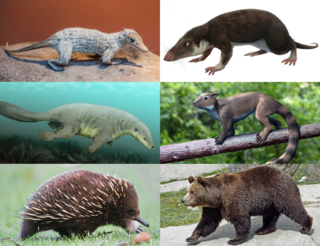
Mammaliaformes is a clade that contains the crown group mammals and their closest extinct relatives; the group radiated from earlier probainognathian cynodonts. It is defined as the clade originating from the most recent common ancestor of Morganucodonta and the crown group mammals; the latter is the clade originating with the most recent common ancestor of extant Monotremata, Marsupialia, and Placentalia. Besides Morganucodonta and the crown group mammals, Mammaliaformes includes Docodonta and Hadrocodium.
Tritylodontidae is an extinct family of small to medium-sized, highly specialized mammal-like cynodonts, with several mammalian traits including erect limbs, endothermy and details of the skeleton. They were the last-known family of the non-mammaliaform synapsids, persisting into the Early Cretaceous.

Volaticotherium antiquum is an extinct, gliding, insectivorous mammal that lived in Asia during the Jurassic period, around 164 mya. It is the only member of the genus Volaticotherium.

The evolution of mammals has passed through many stages since the first appearance of their synapsid ancestors in the Pennsylvanian sub-period of the late Carboniferous period. By the mid-Triassic, there were many synapsid species that looked like mammals. The lineage leading to today's mammals split up in the Jurassic; synapsids from this period include Dryolestes, more closely related to extant placentals and marsupials than to monotremes, as well as Ambondro, more closely related to monotremes. Later on, the eutherian and metatherian lineages separated; the metatherians are the animals more closely related to the marsupials, while the eutherians are those more closely related to the placentals. Since Juramaia, the earliest known eutherian, lived 160 million years ago in the Jurassic, this divergence must have occurred in the same period.

Haramiyida is a possibly polyphyletic order of mammaliaform cynodonts or mammals of controversial taxonomic affinites. Their teeth, which are by far the most common remains, resemble those of the multituberculates. However, based on Haramiyavia, the jaw is less derived; and at the level of evolution of earlier basal mammals like Morganucodon and Kuehneotherium, with a groove for ear ossicles on the dentary. Some authors have placed them in a clade with Multituberculata dubbed Allotheria within Mammalia. Other studies have disputed this and suggested the Haramiyida were not crown mammals, but were part of an earlier offshoot of mammaliaformes instead. It is also disputed whether the Late Triassic species are closely related to the Jurassic and Cretaceous members belonging to Euharamiyida/Eleutherodontida, as some phylogenetic studies recover the two groups as unrelated, recovering the Triassic haramiyidians as non-mammalian cynodonts, while recovering the Euharamiyida as crown-group mammals closely related to multituberculates.

Kuehneotherium is an early mammaliaform genus, previously considered a holothere, that lived during the Late Triassic-Early Jurassic Epochs and is characterized by reversed-triangle pattern of molar cusps. Although many fossils have been found, the fossils are limited to teeth, dental fragments, and mandible fragments. The genus includes Kuehneotherium praecursoris and all related species. It was first named and described by Doris M. Kermack, K. A. Kermack, and Frances Mussett in November 1967. The family Kuehneotheriidae and the genus Kuehneotherium were created to house the single species Kuehneotherium praecursoris. Modeling based upon a comparison of the Kuehneotherium jaw with other mammaliaforms indicates it was about the size of a modern-day shrew between 4 and 5.5 g at adulthood.
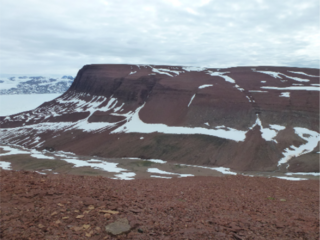
The Fleming Fjord Formation, alternatively called the Fleming Fjord Group is an Upper Triassic geological formation in the northeastern coast of Jameson Land, Greenland. It consists of terrestrial sediments and is known for its fossil content.

Shenshou is a genus of haramiyidan dating from the Oxfordian stage of the Late Jurassic, approximately 160 million years ago. Fossils were recovered from the Tiaojishan Formation in the Liaoning province of China.

Euharamiyida also known as Eleutherodontida, is clade of early mammals or mammal-like cynodonts from the Middle Jurassic to Early Cretaceous of Eurasia and possibly North America. The group is sometimes considered a sister group to Multituberculata, or part of an earlier divergence within the synapsid line. It is disputed whether or not they are related to the Haramiyids from the Late Triassic, such as Haramiyavia. The morphology of their teeth indicates that they were herbivorous or omnivorous. Some members of the group are known to be arboreal, including gliding forms similar to modern flying squirrels or colugos.

Theriimorpha is a clade of mammals defined as including all mammals more closely related to therians than to monotremes. Eutriconodonta is usually considered among the most basal members of this group, with other members more closely related to therians like Allotherians placed in the subclade Theriiformes, though Eutriconodonta has also been recovered as less closely related to therians than monotremes are in some analyses, placing them outside the crown group of Mammalia. The unusual Late Jurassic digging mammal Fruitafossor has also been suggested to be a basal theriimorph.
Vilevolodon is an extinct, monotypic genus of volant, arboreal euharamiyids from the Oxfordian age of the Late Jurassic of China. The type species is Vilevolodon diplomylos. The genus name Vilevolodon references its gliding capabilities, Vilevol, while don is a common suffix for mammalian taxon titles. The species name diplomylos refers to the dual mortar-and-pestle occlusion of upper and lower molars observed in the holotype; diplo, mylos.
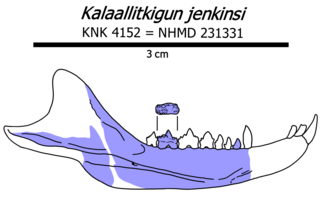
Kalaallitkigun is an extinct genus of haramiyidan mammaliaforms from the Late Triassic of Greenland. It contains a single species, Kalaallitkigun jenkinsi, which was described in 2020 from a partial dentary found in the Fleming Fjord Formation. More specifically, it was found in the mid-late Norian Carlsberg Fjord beds of the Ørsted Dal Member. It is the oldest of several mammaliaform species discovered in the Late Triassic sediments of Greenland. It is also the oldest mammaliaform with double-rooted teeth, and its pattern of tooth cusps help to clarify the evolution of haramiyidan teeth relative to their morganucodont-like ancestors.























